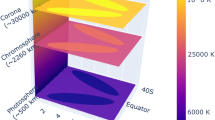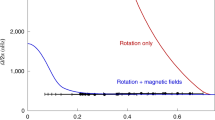Abstract
Determining the sources of solar brightness variations1,2, often referred to as solar noise3, is important because solar noise limits the detection of solar oscillations3, is one of the drivers of the Earth’s climate system4,5 and is a prototype of stellar variability6,7—an important limiting factor for the detection of extrasolar planets. Here, we model the magnetic contribution to solar brightness variability using high-cadence8,9 observations from the Solar Dynamics Observatory (SDO) and the Spectral And Total Irradiance REconstruction (SATIRE)10,11 model. The brightness variations caused by the constantly evolving cellular granulation pattern on the solar surface were computed with the Max Planck Institute for Solar System Research (MPS)/University of Chicago Radiative Magnetohydrodynamics (MURaM)12 code. We found that the surface magnetic field and granulation can together precisely explain solar noise (that is, solar variability excluding oscillations) on timescales from minutes to decades, accounting for all timescales that have so far been resolved or covered by irradiance measurements. We demonstrate that no other sources of variability are required to explain the data. Recent measurements of Sun-like stars by the COnvection ROtation and planetary Transits (CoRoT)13 and Kepler14 missions uncovered brightness variations similar to that of the Sun, but with a much wider variety of patterns15. Our finding that solar brightness variations can be replicated in detail with just two well-known sources will greatly simplify future modelling of existing CoRoT and Kepler as well as anticipated Transiting Exoplanet Survey Satellite16 and PLAnetary Transits and Oscillations of stars (PLATO)17 data.
This is a preview of subscription content, access via your institution
Access options
Access Nature and 54 other Nature Portfolio journals
Get Nature+, our best-value online-access subscription
$29.99 / 30 days
cancel any time
Subscribe to this journal
Receive 12 digital issues and online access to articles
$119.00 per year
only $9.92 per issue
Buy this article
- Purchase on Springer Link
- Instant access to full article PDF
Prices may be subject to local taxes which are calculated during checkout


Similar content being viewed by others
References
Fröhlich, C. Total solar irradiance: what have we learned from the last three cycles and the recent minimum? Space Sci. Rev. 176, 237–252 (2013).
Kopp, G. Magnitudes and timescales of total solar irradiance variability. J. Space Weather Spac. 6, A30 (2016).
Rabello-Soares, M. C., Roca Cortes, T., Jimenez, A., Andersen, B. N. & Appourchaux, T. An estimate of the solar background irradiance power spectrum. Astron. Astrophys. 318, 970–974 (1997).
Ermolli, I. et al. Recent variability of the solar spectral irradiance and its impact on climate modelling. Atmosph. Chem. Phys. 13, 3945–3977 (2013).
Solanki, S. K., Krivova, N. A. & Haigh, J. D. Solar irradiance variability and climate. Ann. Rev. Astron. Astrophys. 51, 311–351 (2013).
Shapiro, A. I. et al. Variability of Sun-like stars: reproducing observed photometric trends. Astron. Astrophys. 569, A38 (2014).
Meunier, N., Lagrange, A.-M., Borgniet, S. & Rieutord, M. Using the Sun to estimate Earth-like planet detection capabilities. VI. Simulation of granulation and supergranulation radial velocity and photometric time series. Astron. Astrophys. 583, A118 (2015).
Hoeksema, J. T. et al. The Helioseismic and Magnetic Imager (HMI) vector magnetic field pipeline: overview and performance. Sol. Phys. 289, 3483–3530 (2014).
Yeo, K. L., Krivova, N. A., Solanki, S. K. & Glassmeier, K. H. Reconstruction of total and spectral solar irradiance from 1974 to 2013 based on KPVT, SoHO/MDI, and SDO/HMI observations. Astron. Astrophys. 570, A85 (2014).
Krivova, N. A., Solanki, S. K., Fligge, M. & Unruh, Y. C. Reconstruction of solar irradiance variations in cycle 23: is solar surface magnetism the cause? Astron. Astrophys. 399, L1–L4 (2003).
Krivova, N. A., Solanki, S. K. & Unruh, Y. C. Towards a long-term record of solar total and spectral irradiance. J. Atmos. Sol.-Terr. Phys. 73, 223–234 (2011).
Vögler, A. et al. Simulations of magneto-convection in the solar photosphere. Equations, methods, and results of the MURaM code. Astron. Astrophys. 429, 335–351 (2005).
Bordé, P., Rouan, D. & Léger, A. Exoplanet detection capability of the COROT space mission. Astron. Astrophys. 405, 1137–1144 (2003).
Borucki, W. J. et al. Kepler planet-detection mission: introduction and first results. Science 327, 977–980 (2010).
Basri, G., Walkowicz, L. M. & Reiners, A. Comparison of Kepler photometric variability with the Sun on different timescales. Astrophys. J. 769, 37 (2013).
Ricker, G. R. et al. Transiting Exoplanet Survey Satellite (TESS). J. Astron. Telesc. Instrum. Syst. 1, 014003 (2015).
Rauer, H. et al. The PLATO 2.0 mission. Exper. Astron. 38, 249–330 (2014).
Schou, J. et al. Design and ground calibration of the Helioseismic and Magnetic Imager (HMI) instrument on the Solar Dynamics Observatory (SDO). Sol. Phys. 275, 229–259 (2012).
Beeck, B., Cameron, R. H., Reiners, A. & Schüssler, M. Three-dimensional simulations of near-surface convection in main-sequence stars. II. Properties of granulation and spectral lines. Astron. Astrophys. 558, A49 (2013).
Aigrain, S., Favata, F. & Gilmore, G. Characterising stellar micro-variability for planetary transit searches. Astron. Astrophys. 414, 1139–1152 (2004).
Seleznyov, A. D., Solanki, S. K. & Krivova, N. A. Modelling solar irradiance variability on time scales from minutes to months. Astron. Astrophys. 532, A108 (2011).
Rast, M. P. The scales of granulation, mesogranulation, and supergranulation. Astrophys. J. 597, 1200–1210 (2003).
Solanki, S. K., Inhester, B. & Schüssler, M. The solar magnetic field. Rep. Progr. Phys. 69, 563–668 (2006).
Bastien, F. A., Stassun, K. G., Basri, G. & Pepper, J. An observational correlation between stellar brightness variations and surface gravity. Nature 500, 427–430 (2013).
Schmutz, W., Fehlmann, A., Finsterle, W., Kopp, G. & Thuillier, G. Total solar irradiance measurements with PREMOS/PICARD. AIP Conf. Proc. 1531, 624–627 (2013).
Fröhlich, C. et al. VIRGO: experiment for helioseismology and solar irradiance monitoring. Sol. Phys. 162, 101–128 (1995).
Fröhlich, C. Solar irradiance variability since 1978. Revision of the PMOD composite during solar cycle 21. Space Sci. Rev. 125, 53–65 (2006).
Shapiro, A. I., Solanki, S. K., Krivova, N. A., Yeo, K. L. & Schmutz, W. K. Are solar brightness variations faculae- or spot-dominated? Astron. Astrophys. 589, A46 (2016).
Aigrain, S. et al. Testing the recovery of stellar rotation signals from Kepler light curves using a blind hare-and-hounds exercise. Mon. Not. R. Astron. Soc. 450, 3211–3226 (2015).
Ludwig, H.-G. et al. Hydrodynamical simulations of convection-related stellar micro-variability. II. The enigmatic granulation background of the CoRoT target HD 49933. Astron. Astrophys. 506, 167–173 (2009).
Fröhlich, C. et al. First results from VIRGO, the experiment for helioseismology and solar irradiance monitoring on SOHO. Sol. Phys. 170, 1–25 (1997).
Fröhlich, C. & Lean, J. Solar radiative output and its variability: evidence and mechanisms. Astron. Astrophys. Rev. 12, 273–320 (2004).
Unruh, Y. C., Solanki, S. K. & Fligge, M. The spectral dependence of facular contrast and solar irradiance variations. Astron. Astrophys. 345, 635–642 (1999).
Kurucz, R. L. “Finding” the “missing” solar ultraviolet opacity. Rev. Mex. Astron. Astrof. 23, 181–186 (1992).
Castelli, F. & Kurucz, R. L. Model atmospheres for VEGA. Astron. Astrophys. 281, 817–832 (1994).
Ball, W. T., Krivova, N. A., Unruh, Y. C., Haigh, J. D. & Solanki, S. K. A new SATIRE-S spectral solar irradiance reconstruction for solar cycles 21–23 and its implications for stratospheric ozone. J. Atmos. Sci. 71, 4086–4101 (2014).
Ortiz, A., Solanki, S. K., Domingo, V., Fligge, M. & Sanahuja, B. On the intensity contrast of solar photospheric faculae and network elements. Astron. Astrophys. 388, 1036–1047 (2002).
Beeck, B., Cameron, R. H., Reiners, A. & Schüssler, M. Three-dimensional simulations of near-surface convection in main-sequence stars. I. Overall structure. Astron. Astrophys. 558, A48 (2013).
Willson, R. C. & Mordvinov, A. V. Secular total solar irradiance trend during solar cycles 21–23. Geophys. Res. Lett. 30, 3–1 (2003).
Dewitte, S., Crommelynck, D., Mekaoui, S. & Joukoff, A. Measurement and uncertainty of the long-term total solar irradiance trend. Sol. Phys. 224, 209–216 (2004).
Dudok de Wit, T., Kopp, G., Fröhlich, C. & Schöll, M. Methodology to create a new total solar irradiance record: making a composite out of multiple data records. Geophys. Res. Lett. 44, 1196–1203 (2017).
Kopp, G., Lawrence, G. & Rottman, G. The Total Irradiance Monitor (TIM): science results. Sol. Phys. 230, 129–139 (2005).
Acknowledgements
The authors received funding from the People Programme (Marie Curie Actions) of the European Union’s Seventh Framework Programme (FP7/2007-2013) under grant agreement No. 624817 and the European Research Council under the European Union’s Horizon 2020 research and innovation programme (grant agreement No. 715947). Financial support was also provided by the Brain Korea 21 plus program through the National Research Foundation funded by the Ministry of Education of Korea and by the German Federal Ministry of Education and Research under project 01LG1209A. We would like to thank the International Space Science Institute, Bern, for their support of science team 373 and the resulting helpful discussions.
Author information
Authors and Affiliations
Contributions
A.I.S., S.K.S. and N.A.K. designed the study. A.I.S. performed the calculations with contributions from R.H.C., who provided the MURaM time series, and K.L.Y., who prepared the HMI/SDO magnetograms and corrected them for noise. N.A.K. and S.K.S. led the development of the SATIRE code. R.H.C. actively contributed to the development of the MURaM code. W.K.S. provided the PREMOS data and expertise on the TSI data. A.I.S., S.K.S., N.A.K. and R.H.C. wrote the paper.
Corresponding author
Ethics declarations
Competing interests
The authors declare no competing financial interests.
Additional information
Publisher’s note: Springer Nature remains neutral with regard to jurisdictional claims in published maps and institutional affiliations.
Electronic supplementary material
Supplementary Information
Supplementary Figures 1–3
Rights and permissions
About this article
Cite this article
Shapiro, A.I., Solanki, S.K., Krivova, N.A. et al. The nature of solar brightness variations. Nat Astron 1, 612–616 (2017). https://doi.org/10.1038/s41550-017-0217-y
Received:
Accepted:
Published:
Issue Date:
DOI: https://doi.org/10.1038/s41550-017-0217-y
This article is cited by
-
Magnetic origin of the discrepancy between stellar limb-darkening models and observations
Nature Astronomy (2024)
-
A Discussion of Implausible Total Solar-Irradiance Variations Since 1700
Solar Physics (2024)
-
Irradiance Variations of the Sun and Sun-Like Stars – Overview of Topical Collection
Solar Physics (2021)
-
Global temperature modes shed light on the Holocene temperature conundrum
Nature Communications (2020)
-
Comparing Radiative Transfer Codes and Opacity Samplings for Solar Irradiance Reconstructions
Solar Physics (2020)



